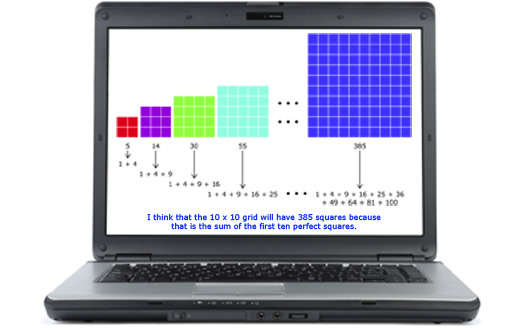Lesson 2
1. Lesson 2
1.1. Explore
Module 2: Logic and Geometry
Explore
conjecture: a conclusion, a generalization, or an educated guess that is based on available evidence but is not yet proved
In Lesson 1 you used the information you were given to discover a pattern in a set of square figures. You then wrote a statement identifying the pattern you determined. For example, you may have stated that the 10 × 10 grid would have 385 squares, which is the sum of the first 10 perfect squares. This is an example of a conjecture.

computer: iStockphoto/Thinkstock
![]()
A perfect square is a number that can be expressed as the square of another number. The numbers 1, 4, 9, 16, 25, 36, and 49 are all perfect squares.
1 × 1 = 1
2 × 2 = 4
3 × 3 = 9
4 × 4 = 16
5 × 5 = 25
6 × 6 = 36
7 × 7 = 49
You developed your conjecture about the number of squares by observing the pattern in the figures. In other words, you used inductive reasoning to develop your conjecture. Inductive reasoning uses specific cases to put together a more general conclusion. For instance, in the squares activity from Lesson 1, your conjecture may have been based on the number of squares in the 2 × 2 grid, the 3 × 3 grid, the 4 × 4 grid, the 5 × 5 grid, and the 10 × 10 grid. You might even have looked at the number of squares in a 6 × 6 grid or an 8 × 8 grid to help establish the pattern. Since it would be very difficult, if not impossible, to look at the number of squares in every possible size of grid, your conjecture of the pattern is based on inductive reasoning.
![]()
inductive reasoning: a type of reasoning used to draw a general conclusion based on experience, observations, or patterns in specific examples